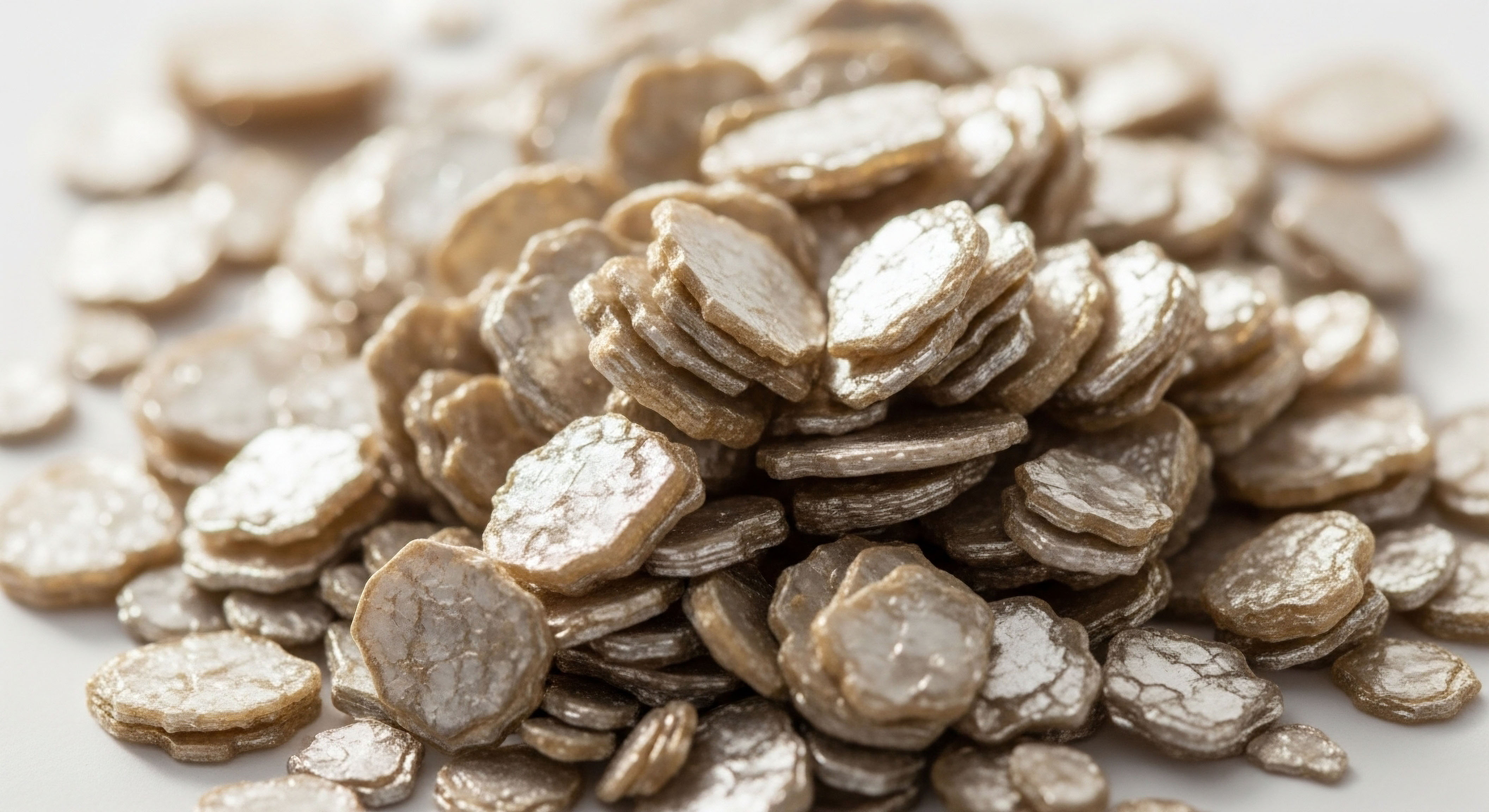

Fundamentals
You feel the shift in your energy, your mood, your body’s very rhythm, and you seek a way to restore your system’s intended function. When you begin a hormonal optimization protocol, you are introducing a precise, powerful set of instructions into your body’s intricate communication network.
Think of administered hormones ∞ like testosterone, progesterone, or peptides ∞ as carefully calibrated messages sent to specific cellular destinations. The effectiveness of this entire process, however, is profoundly shaped by the environment in which these messages are received. Your diet constitutes the primary architect of that environment.
The food you consume does far more than provide simple fuel; it supplies the essential building blocks, the co-factors for enzymatic reactions, and the very signals that determine how efficiently your body can metabolize, utilize, and clear these powerful compounds.
The journey of an administered hormone begins with its absorption and culminates in its eventual breakdown and excretion. A central organ in this process is your liver, the body’s master detoxification hub. It performs a two-step process, known as Phase I and Phase II detoxification, to render hormones water-soluble so they can be eliminated.
Specific foods provide the nutrients that fuel these pathways. Cruciferous vegetables, for instance, including broccoli, cauliflower, and kale, are rich in a compound called sulforaphane. This molecule is a potent activator of Phase II detoxification enzymes, which are critical for processing estrogen metabolites.
For an individual on testosterone replacement therapy (TRT), where managing estrogen levels is a key objective, a diet rich in these vegetables provides a foundational support system, working in concert with medications like Anastrozole to maintain a healthy hormonal equilibrium.
Your diet is the biological landscape that determines how well your body reads and responds to hormonal therapies.
Another critical arena for hormone metabolism is the gut. Your gastrointestinal tract is home to a complex ecosystem of microorganisms, collectively known as the gut microbiome. This internal garden does more than just digest food; it actively participates in regulating your endocrine system.
A specific collection of gut bacteria, sometimes referred to as the “estrobolome,” produces an enzyme that can reactivate estrogen that has been packaged for excretion by the liver. An imbalance in the microbiome, often driven by a diet low in fiber and high in processed foods, can lead to an over-activity of this enzyme, potentially reintroducing estrogen into circulation and disrupting the delicate balance required for effective hormone therapy.
Conversely, a diet rich in prebiotic fibers from sources like asparagus, garlic, and onions, alongside probiotic-rich fermented foods like kefir and sauerkraut, nourishes a healthy microbiome. This fosters an environment where hormones are processed and eliminated efficiently, supporting the goals of your personalized protocol.

The Architecture of Hormonal Communication
Every cell in your body is studded with receptors, which act like docking stations for hormones. The health and sensitivity of these receptors are directly influenced by your nutritional status. Healthy fats, particularly omega-3 fatty acids found in fatty fish like salmon, sardines, and mackerel, as well as in flax and chia seeds, are integral components of cell membranes.
A membrane that is fluid and healthy, built from high-quality fats, allows for optimal receptor function. This means the hormonal messages you are introducing through therapy can be received clearly and effectively. A diet high in processed foods and inflammatory omega-6 fatty acids can lead to cellular inflammation, impairing receptor sensitivity.
This creates a situation akin to having static on a phone line; the message is being sent, but it cannot be heard clearly at its destination. Therefore, the quality of the fats in your diet is a determining factor in the efficacy of any hormonal support strategy.


Intermediate
Understanding that diet influences hormonal balance is the first step. The next is to appreciate the specific biochemical mechanisms through which nutrients modulate the pharmacokinetics of administered hormones. When a hormone like Testosterone Cypionate is injected, its journey through the body is governed by enzymatic processes in the liver and interactions within the gut.
Your dietary choices can either facilitate or hinder this journey, directly impacting both the therapeutic efficacy and the side-effect profile of your protocol. The conversation moves from general wellness to targeted biochemical support, where food becomes a tool for fine-tuning your body’s response to treatment.
The liver’s detoxification system is the primary site of hormone metabolism. This process is not monolithic; it is a sophisticated, two-phase operation. Phase I, mediated by a family of enzymes called Cytochrome P450 (CYP), involves adding a reactive group to the hormone molecule.
Phase II, known as conjugation, attaches another molecule (like glucuronic acid or a sulfate group) to this reactive site, rendering the hormone inactive and water-soluble for excretion. Specific dietary components are essential co-factors for these enzymatic reactions. For example, B vitamins, found in leafy greens and lean proteins, are critical for Phase I enzyme function.
The conjugation reactions of Phase II depend on amino acids from protein, sulfur compounds from garlic and onions, and glucuronic acid, whose production is supported by a healthy overall diet. A deficiency in these micronutrients can create a bottleneck in the detoxification pipeline, leading to a buildup of intermediate metabolites that may have their own biological activity, potentially complicating your hormonal picture.

How Do Dietary Choices Impact Specific Protocols?
Different hormonal therapies have different metabolic considerations, and your diet can be tailored to support the unique demands of each. For a man on TRT with Anastrozole, the primary goal is to manage the aromatization of testosterone into estrogen. Cruciferous vegetables support this by enhancing the clearance of estrogen metabolites through Phase II detoxification.
For a woman using bioidentical progesterone, ensuring adequate levels of Vitamin B6 is important, as it is a cofactor in progesterone synthesis and metabolism. Similarly, magnesium, found in nuts, seeds, and dark chocolate, plays a role in calming the nervous system and can work synergistically with progesterone’s effects. The table below outlines how specific dietary inputs can support common hormonal optimization protocols.
| Dietary Component | Biochemical Action | Relevance to Hormonal Protocols |
|---|---|---|
| Cruciferous Vegetables (Broccoli, Kale) | Provide sulforaphane, which upregulates Phase II liver detoxification enzymes (e.g. glucuronidation). | Enhances clearance of estrogen metabolites, beneficial for both male and female protocols involving testosterone to manage estrogenic side effects. |
| High-Fiber Foods (Oats, Legumes, Psyllium) | Binds to conjugated hormones in the gut, preventing reabsorption and ensuring excretion. Supports a healthy gut microbiome. | Crucial for preventing the recirculation of estrogen, supporting the goals of Anastrozole and promoting overall hormonal balance. |
| Phytoestrogens (Flaxseed, Lentils) | Weakly bind to estrogen receptors, potentially modulating the effects of stronger endogenous or administered estrogens. | May be beneficial in perimenopausal protocols to help buffer against fluctuating estrogen levels. Their role in TRT is complex and requires careful consideration. |
| Omega-3 Fatty Acids (Salmon, Chia Seeds) | Incorporated into cell membranes, enhancing receptor sensitivity and reducing cellular inflammation. | Improves the ability of cells to receive signals from administered hormones like testosterone and growth hormone peptides, enhancing protocol effectiveness. |
| Lean Protein (Chicken, Fish, Legumes) | Provides essential amino acids (e.g. glycine, taurine) required for Phase II conjugation pathways in the liver. | Ensures the liver has the raw materials needed to metabolize and clear hormones efficiently, preventing the buildup of active metabolites. |

The Gut Microbiome as an Endocrine Organ
The community of bacteria in your gut has a direct and profound impact on hormone metabolism. The estrobolome, the subset of gut microbes that metabolizes estrogens, is a key player. An unhealthy microbiome, often resulting from a diet high in sugar and low in fiber, can lead to increased levels of the enzyme beta-glucuronidase.
This enzyme essentially “unwraps” estrogens that the liver has packaged for excretion, allowing them to re-enter circulation. This can undermine the intended effects of a protocol, particularly when precise estrogen control is necessary. Dietary fiber acts as a primary fuel source for beneficial gut bacteria, which in turn produce short-chain fatty acids (SCFAs) like butyrate.
These SCFAs have anti-inflammatory effects and help maintain the integrity of the gut lining, further contributing to a stable endocrine environment. A high-fiber diet, therefore, is not just about regularity; it is a direct intervention to support the healthy metabolism of administered hormones.


Academic
A sophisticated understanding of hormone metabolism requires moving beyond simple dietary recommendations to a systems-biology perspective. The efficacy of any administered hormone or peptide is contingent upon the metabolic state of the individual, a state that is largely dictated by long-term dietary patterns.
Chronic consumption of a high-glycemic, processed-food diet induces a state of low-grade systemic inflammation and metabolic dysfunction, characterized by phenomena such as insulin and leptin resistance. This condition fundamentally alters the cellular and systemic environment, thereby modulating the pharmacodynamics of exogenous hormonal therapies. The conversation must therefore encompass the intricate interplay between nutrient sensing pathways, inflammatory cascades, and the Hypothalamic-Pituitary-Gonadal (HPG) axis.
Leptin, an adipocyte-derived hormone, and insulin, secreted by the pancreas, are primary regulators of energy homeostasis. In a healthy system, these hormones provide negative feedback to hypothalamic neurons, signaling satiety and metabolic sufficiency. However, a chronic surplus of energy, particularly from refined carbohydrates and fats, leads to hyperinsulinemia and hyperleptinemia.
Over time, the hypothalamic receptors for these hormones become desensitized, a state known as leptin and insulin resistance. This resistance has profound implications for anyone on a hormonal protocol. The hypothalamus, being unable to accurately sense the body’s energy status, can send dysregulated signals down the HPG axis.
For a man on TRT, this can interfere with the intended suppression of luteinizing hormone (LH) and follicle-stimulating hormone (FSH). For someone using a fertility-stimulating protocol with Gonadorelin or Clomid, underlying insulin resistance can impair the desired pituitary response. The administered hormones are entering a system where the central command center is already receiving corrupted information.
Metabolic dysfunction creates a background of endocrine noise that can distort the clear signal of hormonal therapy.

Molecular Mechanisms of Nutrient-Hormone Interaction
The interaction between diet and hormone metabolism extends to the level of gene expression and enzymatic function. The Cytochrome P450 enzymes responsible for Phase I detoxification are a prime example. The activity of these enzymes can be induced or inhibited by various dietary compounds.
For instance, compounds in grapefruit are well-known inhibitors of the CYP3A4 enzyme, which is involved in the metabolism of many medications and hormones. While this is a prominent example, many other phytonutrients can exert similar, if more subtle, effects. The balance of dietary fatty acids is another critical factor.
Omega-6 fatty acids, prevalent in vegetable oils and processed foods, are precursors to pro-inflammatory eicosanoids like prostaglandin E2. Omega-3 fatty acids, from marine sources, are precursors to anti-inflammatory eicosanoids.
An imbalance in favor of omega-6s promotes a pro-inflammatory state at the cellular level, which can impair mitochondrial function, increase oxidative stress, and reduce the sensitivity of hormone receptors throughout the body. This directly impacts the efficacy of therapies designed to improve cellular function, such as growth hormone peptide therapy.

Nutrient Cofactors in Steroidogenesis and Metabolism
The synthesis and metabolism of steroid hormones are multi-step enzymatic processes that are dependent on specific micronutrient cofactors. A deficiency in any of these can impair the body’s ability to both produce its own hormones and metabolize administered ones. The table below details some of these critical relationships.
| Micronutrient | Role in Hormone Metabolism | Dietary Sources |
|---|---|---|
| Magnesium | Cofactor for enzymes involved in insulin signaling and the synthesis of steroid hormones. Associated with improved insulin sensitivity. | Leafy green vegetables, nuts, seeds, dark chocolate. |
| Zinc | Essential for the synthesis of testosterone and the function of the HPG axis. Acts as a cofactor for hundreds of enzymes. | Oysters, red meat, poultry, beans, nuts. |
| Vitamin D | Functions as a pro-hormone itself and is correlated with healthy testosterone levels. Modulates immune function and inflammation. | Fatty fish, fortified milk, sun exposure. |
| B Vitamins (B5, B6) | Critical for adrenal function and the production of stress hormones. B6 is a key cofactor in the metabolism of progesterone and neurotransmitters. | Meat, poultry, fish, potatoes, chickpeas. |
| Selenium | Essential for thyroid hormone production (conversion of T4 to the active T3 form) and antioxidant defense (glutathione peroxidase). | Brazil nuts, seafood, organ meats. |
Ultimately, the metabolism of administered hormones cannot be viewed in isolation. It is deeply embedded within the broader metabolic health of the individual. A diet that promotes insulin sensitivity, resolves chronic inflammation, and provides the necessary micronutrient cofactors creates a biological environment conducive to the success of hormonal optimization protocols. Therapeutic interventions are most effective when applied to a system that is foundationally sound. Nutritional strategy, therefore, is a primary and non-negotiable component of advanced hormonal care.

References
- “How Does Food Affect Your Hormones?” The Marion Gluck Clinic, Accessed July 21, 2024.
- Weickert, Martin O. and Andreas F. H. Pfeiffer. “Metabolic Effects of Dietary Fiber Consumption and Prevention of Diabetes.” The Journal of Nutrition, vol. 138, no. 3, 2008, pp. 439-442.
- Klok, M. D. S. Jakobsdottir, and M. L. Drent. “The role of leptin and ghrelin in the regulation of food intake and body weight in humans ∞ a review.” Obesity Reviews, vol. 8, no. 1, 2007, pp. 21-34.
- Puig, Roser, et al. “The role of gut hormones in controlling the food intake. What is their role in emerging diseases?” Endocrinología y Nutrición (English Edition), vol. 59, no. 3, 2012, pp. 178-186.
- Naidoo, Omy. “How does the food we eat affect our hormones?” Interview. Newzroom Afrika, 22 Feb. 2024.
- Hu, Frank B. et al. “Diet, lifestyle, and the risk of type 2 diabetes mellitus in women.” New England Journal of Medicine, vol. 345, no. 11, 2001, pp. 790-797.
- “The Anatomy Of A Hormone Balancing Plate.” The Marion Gluck Clinic, Accessed July 21, 2024.

Reflection
You now possess a deeper awareness of the connection between your plate and your protocol. The information presented here is a map, illustrating the biological pathways that link what you eat to how you feel. It shows that your daily nutritional choices are a constant, powerful conversation with your endocrine system.
This knowledge shifts the perspective on diet from a set of restrictions to a series of opportunities ∞ opportunities to support your body’s healing, to enhance the clarity of its internal communication, and to build a foundation upon which personalized medicine can achieve its greatest effect.
The next step on this path involves looking at your own life, your own patterns, and your own body. How might you begin to apply this understanding in a way that aligns with your unique biology and your personal goals for vitality? This is where the true work of reclaiming your health begins, transforming scientific knowledge into lived experience.

Glossary

phase ii detoxification

cruciferous vegetables

hormone metabolism

gut microbiome

estrobolome

omega-3 fatty acids

fatty acids

cytochrome p450

leptin resistance

insulin resistance




